| | 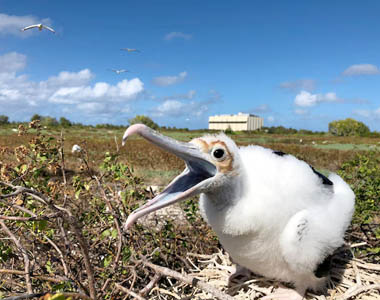 Can anyone stop Elon Musk from despoiling the Earth, Mars, or the government? A squawking Great Frigatebird Chick has done it! There are a million seabirds, including Great Frigatebirds, Sooty Terns, and many others who nest on Johnston Atoll in the Pacific, the very spot the Air Force had planned to carry out tests of Musk’s SpaceX rockets. That is until biologists and experts weighed in that the rocket blasts would harm nesting seabirds. Can anyone stop Elon Musk from despoiling the Earth, Mars, or the government? A squawking Great Frigatebird Chick has done it! There are a million seabirds, including Great Frigatebirds, Sooty Terns, and many others who nest on Johnston Atoll in the Pacific, the very spot the Air Force had planned to carry out tests of Musk’s SpaceX rockets. That is until biologists and experts weighed in that the rocket blasts would harm nesting seabirds.
There are additional threats to birds from the Trump Administration and DOGE cutbacks, as well as the continuing problems of climate change, pollution, pesticides, and more. But as you kick back for summer, our July issue of RCC’s Bird Watch and Wonder celebrates the astounding beauty, resilience, and intelligence of our avian allies who not only are smart enough to take on Elon Musk, but also to show off their stuff to humans so that we want to see, visit, learn about and protect them. That’s why volunteers at beaches with ground nesting Piping Plovers are steering people away from the clearly marked areas that have been set aside for one of the cutest shorebirds, or restoring marshlands in North Carolina for the rarely seen Black Rail, a tiny bird with legs only an inch long! It was once abundant across the state, but is now endangered by development and sea level rise. 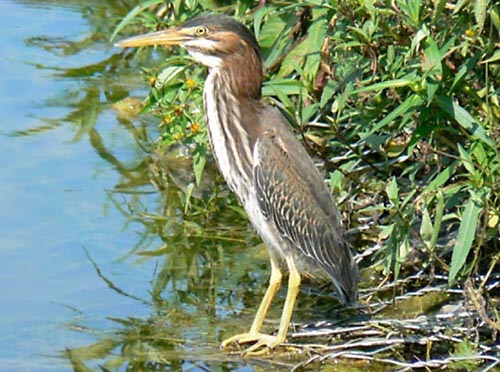 In our “Bird Lore” section, curious fellow that he is, RCC’s own birdmeister, Ross Feldner, has gathered together the astounding tool making abilities of numerous birds. Robins, for example, actually rub ants around their bodies to use their formic acid as a natural insecticide! My favorite? The Green Heron. Uncommon, but regular residents where I bird along the C&O Canal, these colorful small hunters actually lure fish closer to them by casting insects or bits of bread out onto the water. In our “Bird Lore” section, curious fellow that he is, RCC’s own birdmeister, Ross Feldner, has gathered together the astounding tool making abilities of numerous birds. Robins, for example, actually rub ants around their bodies to use their formic acid as a natural insecticide! My favorite? The Green Heron. Uncommon, but regular residents where I bird along the C&O Canal, these colorful small hunters actually lure fish closer to them by casting insects or bits of bread out onto the water.
So. Ready to see and admire some fascinating, brainy and beautiful birds? As you head off to vacation, take a look in our “Bird Findings” section at “10 Birds to See at National Wildlife Refuges.” Puffins, pelicans, eagles are waiting for you! The gorgeous photos of these stunners alone will make you want to get out the door. Then just keep going, using our “Bird Festivals and Events” as a cross-country guide. You will fall even more deeply in love with our avian allies and friends. See you in September! | | | | | | 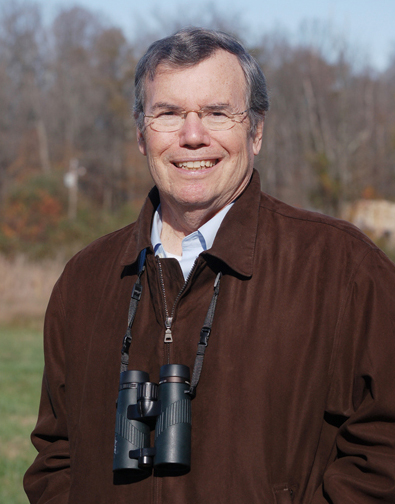 Bob Musil is the President & CEO of the Rachel Carson Council and author of Rachel Carson and Her Sisters: Extraordinary Women Who Have Shaped America’s Environment (Rutgers, 2016) and Washington in Spring: A Nature Journal for a Changing Capital (Bartleby, 2016). He is also the editor of the forthcoming annotated edition from Rutgers University Press of Rachel Carson’s Under the Sea-Wind with his Introduction, updated marine science, and historic and contemporary illustrations and photographs. Bob Musil is the President & CEO of the Rachel Carson Council and author of Rachel Carson and Her Sisters: Extraordinary Women Who Have Shaped America’s Environment (Rutgers, 2016) and Washington in Spring: A Nature Journal for a Changing Capital (Bartleby, 2016). He is also the editor of the forthcoming annotated edition from Rutgers University Press of Rachel Carson’s Under the Sea-Wind with his Introduction, updated marine science, and historic and contemporary illustrations and photographs. | | | | | | US Air Force Suspends SpaceX Rocket Project on Pacific Atoll, Report Says The U.S. Air Force has suspended plans it had proposed with Elon Musk's SpaceX to test hypersonic rocket cargo deliveries from a remote Pacific atoll, according to a report this week in Stars and Stripes, an independent publication of the U.S. military. The suspension came after Reuters reported that biologists and experts said the project would harm many seabirds that nest at the wildlife refuge on the Johnston Atoll, an unincorporated U.S. territory nearly 800 miles (1,300 km) southwest of Hawaii. | | | | | | | | Plan Would Address Threatened Eastern Black Rails’ Habitat Loss There was a time when the distinctive “kiki-do” call of eastern black rails were a common sound rising up from North Carolina marshes. Masters of secrecy, these little birds are rarely, if ever, seen. They prefer to skirt through the marsh using tunnels dug by rabbits and other small mammals rather than take to the sky. Their nests are typically well concealed close to the ground in the highest part of brackish, saltwater and inland freshwater marshes. | | | | | | | | As Temperatures Surge, Sunbathers and Shorebirds Look to Share Wrightsville Beach Both like sand and being at the coast. But sometimes humans and birds find it hard to share the beach. A recent report highlights the decline of bird species nationally, with shorebirds particularly at risk due to habitat loss, climate change, and human interaction. Volunteers and signage help manage human interaction with the birds in protected areas, educating beachgoers about sharing the space with nesting birds. | | | | | | | | What We’ll Lose If Bird Banding Ends Scientists have tagged birds for more than 100 years. That preservation program might be defunded. I did not know much about bird banding until I signed up to take part in an owl study in my neighborhood outside Portland, Oregon. A federally licensed bird bander named Alexander Lauber installed a wooden owl box in a cherry tree in my backyard. Owl boxes re-create the tree cavities where owls nest in nature. | | | | | | | | Minnesota Corn Fields Pose Migration Risk For Songbirds, Study Shows Twice a year, billions of songbirds race through Minnesota’s skies, making their journey between the U.S. and South America in search of richer resources and gentler weather. But for many songbirds, flapping through Minnesota isn’t easy. In new research from Cornell University, scientists have found that the Corn Belt’s large stretch of farmland forces songbirds to alter their natural flight patterns. | | | | | | | | Birds in Tiny 'backpacks' Might Provide More Insights to New England Marsh Restoration Projects Some salt marsh sparrows out on New Hampshire’s seacoast are now flying around with brand new backpacks. The accessory is actually a solar-powered tag the size of a fingernail, which will help University of New Hampshire researchers provide important data for marsh restoration projects across New England. In late June, the research team set out at five in the morning to tag the tiny birds on Lubberland Creek. | | | | | | | | Trump’s Budget Would Clip Bird Banding. Hunters Are Not Happy. The Bird Banding Laboratory has turned duck hunters into citizen scientists. What happens if it is defunded? For more than a century, the Bird Banding Laboratory has placed small metallic bands on the legs of birds across North America. Each year, the lab receives thousands of reports from bird watchers and biologists who spot the markers on the birds and report them to the lab. In this way, the lab tracks and monitors the movements and numbers of birds, from sparrows to sparrow hawks. | | | | | | | | NASA-Assisted Scientists Get Bird’s-Eye View of Population Status NASA satellite data and citizen science observations combine for new findings on bird populations. Through the eBird citizen scientist program, millions of birders have recorded their observations of different species and submitted checklists to the Cornell Lab of Ornithology. Through a partnership with NASA, the lab has now used this data to model and map bird population trends for nearly 500 North American species. | | | | | | | | Birdist Rule #71: Figure Out What Kind Of Chickadees You’ve Got I’ve probably said this about every bird at one time or another, but this time I mean it: Chickadees are the best birds. They’re just the best. They’re cute. They’re cool-looking. They make a lot of noise to let you know they’re coming. No one has ever been disappointed to see a chickadee. But how much do you really know about the chickadee you see in your woods or at your feeder? Do you know, say, which of the seven chickadee species found in the United States it happens to be? | | | | | | | | The Secret to Song Sparrows’ Extraordinary Success Lies in Their Genome This ordinary-seeming songbird species is teeming with subtle genetic diversity, which allows local populations to respond in various ways to a changing world. f you’re a birder in North America, you’re almost certainly familiar with Song Sparrows. Because they’re found everywhere—from the deserts and volcanoes of Mexico to the outlying islands of Alaska. | | | | | | | | 10 Birds to See at National Wildlife Refuges Try Spotting These Distinctive-Looking Birds Which birds are the best to look for on national wildlife refuges? Those you most like to see. That might mean large-winged birds with flashy mating displays. Or bright-beaked wading birds that are fun to watch feed. Or maybe a small bird that flies record-setting distances each spring. With more than 700 bird species on refuges, you have a wide choice. Here are a few kinds of birds to consider. | | | | | | | | The Search for One of North America’s Rarest Birds Scientists must journey to remote islands in the middle of the Bering Sea, braving uncertain conditions, to reach the breeding grounds of McKay's Buntings. In the middle of Alaska’s Bering Sea, St. Matthew Island and its much smaller neighbor Hall Island are among the few specks of land amid hundreds of square miles of water. These uninhabited volcanic isles host an impressive array of Arctic birds, including one of North America’s most enigmatic species: the McKay’s Bunting, which breeds only here. | | | | | | | | | | Mountain Chickadees Change Their Tune When They Live Beside Black-capped Chickadees As human-altered habitats bring two closely related chickadees together, one species' song seems to be evolving to help them tell each other apart. Black-capped Chickadees and Mountain Chickadees are close evolutionary cousins that look a lot alike, and they sound a lot alike, too—both sing sweet, multinote fee-bee whistles, with the Mountain Chickadee usually articulating a few more notes than the Black-capped. | | | | | | | | The Right Tool for the Right Job A good tool improves the way you work. A great tool improves the way you think. – Jeff Duntemann Although we are familiar with primates using tools, there are many birds that have developed tool-usage skills, among them capturing insects in tree bark crevices using a stick or using lures to attract fish. Tool use by birds has been defined as the manipulation of inanimate objects so as to extend the physical capabilities of the bird. Some birds use animate objects as well. | | | | | | | | Why Do Gulls Like Hanging Out in Parking Lots? A question we've all wondered. An answer that might surprise you. Walk through a mall parking lot, and you might just stumble into sudden fame—with an audience of gulls, that is. But you’re not carrying a sandwich, and there’s no ocean here. Just a field of pavement with seemingly little appeal for any bird, much less one that people associate with boardwalks and beach vacations. | | | | | | | | The Questions Started With the Wren Of all the nest boxes in our yard, the Carolina chickadees always choose the hanging box in the rose arbor. Every year the female builds her beautiful nest of moss and lays her clutch of speckled eggs. How many eggs? I never know. With chickadees it can be as many as a dozen, as few as three. But if I hear the glorious, burbling river of song that means a northern house wren has arrived, I know the chickadees don’t stand a chance. A house wren is a tiny, feathered terrorist. | | | | | | | | How a Parasitic Bird With No Parents Learns What Species It Is Cowbird mothers abandon their eggs in the nests of other bird species, but the chicks somehow manage to find their flock and learn what they really are. In P.D. Eastman’s classic picture book “Are You My Mother?” a baby bird hatches alone and goes on a quest. It asks a cow, a dog, and even an excavator whether they might be its mother. Finally, the chick and its true mom reunite. | | | | | | | | The Folklore of Birds Birds have been creatures of the mythic imagination since the very earliest times. Various birds, from eagles to starlings, serve as messengers to the gods in stories the world over, carrying blessings to humankind and prayers up to the heavens. They lead shamans into the Spirit World and dead souls to the Realm Beyond; they follow heroes on quests, uncover secrets, give warning and shrewd council. The movements, cries and migratory patterns of birds have been studied as oracles. | | | | | | | | Sackville Artist Communicates Thoughts Through Bird Portraits, Sculptures Mixed-media artist Indu Varma of Sackville, N.B., looks at birds from a different perspective. Varma, who grew up in India, has created a 16-piece exhibit called Birds & their Symbolism. It is inspired by stories from Hindu mythology, symbolic meanings of birds across different cultures, and her childhood experiences. The exhibit of paintings and sculptures will be displayed at the Saint John Arts Centre until Aug. 29. | | | | | | | | Festivals by Location A great way to enjoy birdwatching is by going to festivals—they’re organized to get you to well-known birding spots at the right time of year, and they’re a perfect way to meet people. Experts and locals help you see more birds, and you’ll meet other visitors who share your hobby. While you’re there, keep an eye out for Cornell Lab representatives, as we do attend several festivals each year. | | | | | | | | Whooping Crane Before humans began altering their habitat, it is estimated there were 15,000 to 20,000 Whooping Cranes. By the 1800’s and early 1900s, hunting and habitat loss began to reduce their numbers drastically. By 1860 there were only about 1,400 and in 1941 their population had fallen to the shockingly low number of 15! It seemed they were on the verge of extinction. These last few survivors were all part of a single flock that migrated between Canada and Texas. | | | | | | | | Momentary Meditations are published every Monday to awaken what Rachel Carson called “the sense of wonder” and what Albert Schweitzer called “a reverence for life.” Looking deeply into our interdependence with all life on earth helps us know what we must do. In our harried world, these meditations are meant to serve as a renewable resource for compassion and love. The Grace of an Eagle - Watching this eagle slowly and deliberately prepare for flight caused me to confess that too often I get lost in mindless waiting or unnecessary rushing and overlook the power of resting “in the grace of the world”, as Wendell Berry puts it in his poem The Peace of Wild Things | | | | | | | | | | | By Jon Young 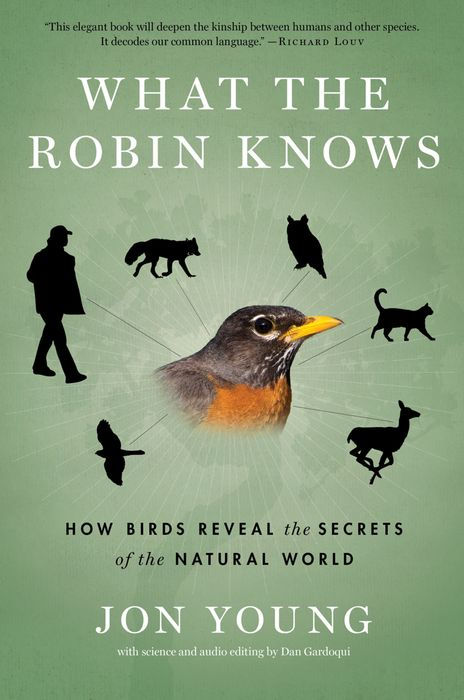 Award-winning naturalist and author Jon Young's What the Robin Knows reveals how understanding bird language and behavior can help us to see more wildlife. Award-winning naturalist and author Jon Young's What the Robin Knows reveals how understanding bird language and behavior can help us to see more wildlife.
A lifelong birder, tracker, and naturalist, Jon Young is guided by three basic premises: the robin, junco, and other songbirds know everything important about their environment, be it backyard or forest; by tuning in to their vocalizations and behavior, we can acquire much of this wisdom for our own pleasure and benefit; and the birds’ companion calls and warning alarms are just as important as their songs.
Deep bird language is an ancient discipline, perfected by Indigenous peoples the world over, and science is finally catching up. This groundbreaking book unites the Indigenous knowledge and the author’s own experience of more than four decades in the field to lead us toward a deeper connection to the animals and, in the end, a deeper connection to ourselves.
“This elegant book will deepen the kinship between humans and other species. It decodes our common language.”—Richard Louv, author of Our Wild Calling: How Connecting with Animals Can Transform Our Lives—and Save Theirs. Purchase here | | | | | | | | | | | 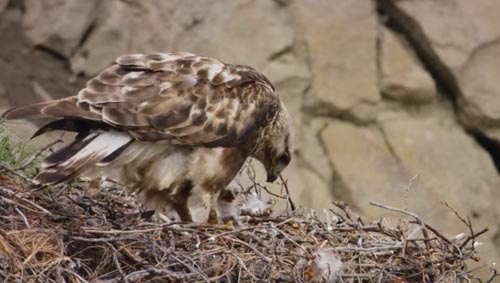 Alaska’s Colville River is internationally recognized for its extraordinary raptor populations. The river drains much of the North Slope of Alaska as it winds more than 400 miles to the Arctic Ocean. Its steep cliffs host among the highest densities of nesting birds of prey in the entire Arctic: Peregrine Falcons, Gyrfalcons, Golden Eagles, and Rough-legged Hawks all raise their young here. The area is also home to caribou, moose, wolves, grizzly bears, and fish and provides subsistence resources for Alaska Native communities. Alaska’s Colville River is internationally recognized for its extraordinary raptor populations. The river drains much of the North Slope of Alaska as it winds more than 400 miles to the Arctic Ocean. Its steep cliffs host among the highest densities of nesting birds of prey in the entire Arctic: Peregrine Falcons, Gyrfalcons, Golden Eagles, and Rough-legged Hawks all raise their young here. The area is also home to caribou, moose, wolves, grizzly bears, and fish and provides subsistence resources for Alaska Native communities. Much of the area along the river is designated as the Colville River Special Area, one of five unique wilderness regions in northern Alaska recognized by the Bureau of Land Management as having exceptional wildlife and subsistence values that deserve maximum protection in the face of development. These five areas have been set aside since the 1970s because of their global importance to migratory birds, Arctic wildlife, and people. Read more about Alaska’s Special Areas and the wildlife that depend on them. But in 2025, Special Areas are under imminent threat of losing their protections from proposals that aim “to allow the maximum possible extraction of gas and oil to meet the Nation’s total energy need,” according to the Federal Register. Watch here | | | | | | The July 2025 issue of Bird Watch and Wonder was produced by Ross Feldner | | | |  The Rachel Carson Council Depends on Tax-deductible Gifts From Concerned Individuals Like You. Please Help If You can. The Rachel Carson Council Depends on Tax-deductible Gifts From Concerned Individuals Like You. Please Help If You can. | | | |  Sign Up Here to Receive the RCC E-News and Other RCC Newsletters, Information and Alerts. Sign Up Here to Receive the RCC E-News and Other RCC Newsletters, Information and Alerts. | | | | | | | | | | | |